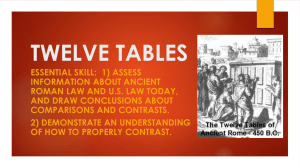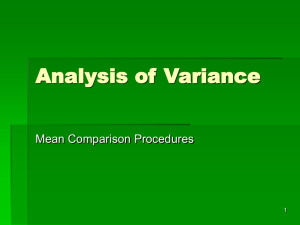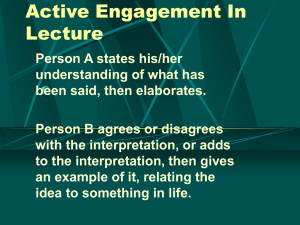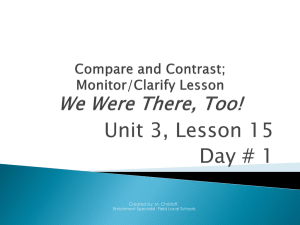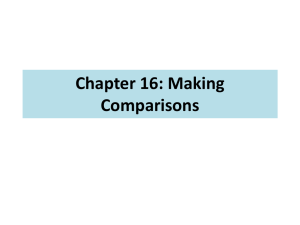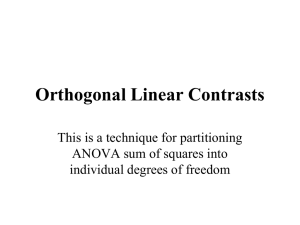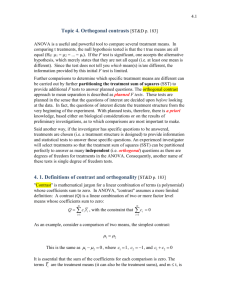MULTIPLE COMPARISON TESTS
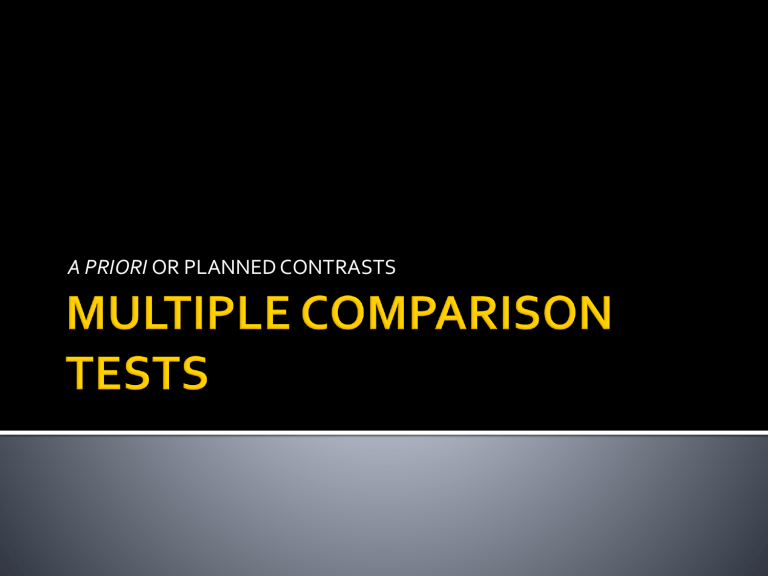
A PRIORI OR PLANNED CONTRASTS
ANOVA is used to compare means.
However, if a difference is detected, and more than two means are being compared,
ANOVA cannot tell you where the difference lies.
In order to figure out which means differ, you can do a series of tests:
Planned or unplanned comparisons of means.
A comparison between means identified as being of utmost interest during the design of a study, prior to data collection.
You can only do one or a very small number of planned comparisons, otherwise you risk inflating the Type 1 error rate.
You do not need to perform an ANOVA first.
A form of “data dredging” or “data
snooping”, where you may perform comparisons between all potential pairs of means in order to figure out where the difference(s) lie.
No prior justification for comparisons.
Increased risk of committing a Type 1 error.
The probability of making at least one type 1 error is not greater than α= 0.05.
Planned comparisons may be orthogonal or non-orthogonal.
Orthogonal: mutually non-redundant and uncorrelated contrasts (i.e.: independent).
Non-Orthogonal: Not independent.
For example:
4 means: Y
1
,Y
2
, Y
3
, and Y
4
Orthogonal: Y
1
-Y
2 and Y
3
-Y
4
Non-Orthogonal: Y
1
-Y
2 and Y
2
-Y
3
Limited number of contrasts can be made, simultaneously.
Any set of contrasts may have k-1 number of contrasts.
For Example:
k=4 means.
Therefore, you can make 3 (i.e.: 4-1) orthogonal contrasts at once.
∑c ij c i’j
=0
where the c’s are the particular coefficients associated with each of the means and the i indicates the particular comparison to which you are referring.
Multiply all of the coefficients for each particular mean together across all comparisons.
Then add them up!
If that sum is equal to zero, then the comparisons that you have in your set may be considered orthogonal.
For Example:
Set c ij c i’j
∑c ij c i’j
1 c 1
1
-
½
½
Coefficients c 2 c 3
-1 -
-
½
1
-½
-½ -½
Contrasts c 4
-
-1
Y
1
-Y
2
Y 3 -Y 4
-½ (Y
1
+Y
2
)/2 –(Y
3
+Y
4
)/2
½
0
(After Kirk 1982) (c
1
)Y
1
+ (c
2
)Y
2
Therefore c
1
= Y
1
–Y
2
= 1 and c
2
(1)Y
1
+ (-1)Y
2
= Y
1
-Y
2
= -1 because
There are always k-1 non-redundant questions that can be answered.
An experimenter may not be interested in asking all of said questions, however.
A planned comparison addresses the null
hypothesis that all of your comparisons between means will be equal to zero.
Ho=Y
1
-Y
2
=0
Ho= Y
3
-Y
4
=0
Ho= (Y
1
+Y
2
)/2 –(Y
3
+Y
4
)/2
These types of hypotheses can be tested using a t statistic.
Very similar to a two sample t-test, but the
standard error is calculated differently.
Specifically, planned comparisons use the
pooled sample variance (MS error
)based on all
k groups (and the corresponding error degrees of freedom) rather than that based only on the two groups being compared.
This step increases precision and power.
Evaluate just like any other t-test.
Look up the critical value for t in the same
table.
If the absolute value of your calculated t statistic exceeds the critical value, the null hypothesis is rejected.
All of the t statistic calculations for all of the comparisons in a particular set will use the same
MS error
.
Thus, the tests themselves are not statistically
independent, even though the comparisons that you are making are.
However, it has been shown that, if you have a sufficiently large number of degrees of
freedom (40+), this shouldn’t matter.
(Norton and Bulgren, as cited by Kirk, 1982)
You can also use an F statistic for these tests, because t 2 = F.
Different books prefer different methods.
The book I liked most used the t statistic, so that’s what I’m going to use throughout.
SAS uses F, however.
A confidence interval is a way of expressing the precision of an estimate of a parameter.
Here, the parameter that we are estimating is the value of the particular contrast that we are making.
So, the actual value of the comparison (ψ) should be somewhere between the two extremes of the confidence interval.
The values at the extremes are the 95%
confidence limits.
With them, you can say that you are 95% confident that the true value of the comparison lies between those two values.
If the confidence interval does not include
zero, then you can conclude that the null hypothesis can be rejected.
When the data are presented this way, it is possible for the experimenter to consider all
possible null hypotheses – not just the one that states that the comparison in question will equal 0.
If any hypothesized value lies outside of the
95% confidence interval, it can be rejected.
Orthogonal tests can be done in either way.
Both methods make the same assumptions and are equally significant.
Assumptions:
The populations are approximately normally
distributed.
Their variances are homogenous.
The t statistic is relatively robust to violations of these assumptions when the number of observations for each sample are equal.
However, when the sample sizes are not equal, the t statistic is not robust to the heterogeneity
of variances.
When population variances are unequal, you can replace the pooled estimator of variance, MS error with individual variance estimators for the
, means that you are comparing.
There are a number of possible procedures that can be used when the variance between populations is heterogeneous:
Cochran and Cox
Welch
Dixon, Massey, Satterthwaite and Smith
For C independent contrasts at some level of significance (α), the probability of making one or more Type 1 errors is equal to:
1-(1-α) C
As the number of independent tests
increases, so does the probability of committing a Type 1 error.
This problem can be reduced (but not eliminated) by restricting the use of multiple t-tests to a priori orthogonal contrasts.
Contrasts of interest that ARE NOT independent.
In order to reduce the probability of making a
Type 1 error, the significance level (α) is set for the whole family of comparisons that is being made, as opposed to for each individual comparison.
For Example:
Entire value of α for all comparisons combined is
0.05.
The value for each individual comparison would thus be less than that.
When contrasts are planned in advance.
They are relatively few in number.
BUT the comparisons are non-orthogonal
(they are not independent).
i.e.: When one wants to contrast a control
group mean with experimental group
means.
A.K.A.: Bonferoni t procedure.
Involves splitting up the value of α among a set of planned contrasts in an additive way.
For example:
Total α = 0.05, for all contrasts.
One is doing 2 contrasts.
α for each contrast could be 0.025, if we wanted to divide up the α equally.
If the consequences of making a Type 1 error are not equally serious for all contrasts, then you may choose to divide α unequally across all of the possible comparisons in order to reflect that concern.
This procedure also involves the calculation of a t statistic (tD).
The calculation involved in finding tD is
identical to that for determining t for orthogonal tests:
However, you use a different table in order to look up the critical value (tD
α;C,v
).
Your total α value (not the value per comparison).
Number of comparisons (C).
And v, the number of degrees of freedom.
The table also only shows the critical values for two-tailed tests.
However, you can determine the
approximate value of tD
α;C,v
for a onetailed test by using the following equation:
tD
α;C,v
≈ z
α/C
+ (z 3
α/C
+ z
α/C
)/4(v-2)
▪ Where the value of z
α/C can be looked up in yet
another table (“Areas under the Standard Normal
Distribution”).
Instead of calculating tD for all contrasts of interest, you can simply calculate the critical
difference (ψD) that a particular comparison must exceed in order to be significant:
ψD = tD
α/2;C,v
√(2MS error
/n).
Then compare this critical difference value to the absolute values of the differences between the means that you compared.
If they exceed ψD, they are significant.
Y
1
Y
2
Y
3
Y
4
Y
5
For Example:
Those differences that exceed the calculated value of ΨD (8.45, in this case) are significant.
Differences between means are:
MEANS Y
1
Y
2
Y
3
Y
4
Y
5
12.0
-
6.7
5.3
-
10.5
1.5
3.8
-
3.6
8.4
3.1
6.9
-
(After Kirk 1982)
A modification of the Dunn procedure.
t statistic (tDS) and critical difference (ψDS).
There isn’t much difference between the two procedures at α < 0.01.
However, at increased values of α, this procedure is considered to be more powerful and more precise.
Calculations are the same for t and ψD.
Table is different.
However, it is not easy to allocate the total value of α unevenly across a particular set of comparisons.
This is because the values of α for each individual comparison are related
multiplicatively, as opposed to additively.
Thus, you can’t simply add the α’s for each comparison together to get the total value of
α for all contrasts combined.
For contrasts involving a control mean.
Also uses a t statistic (tD’) and critical difference
(ψD’).
Calculations are the same for t and ψ.
Different table.
Instead of C, you use k, the number of means
(including the control mean).
Note: unlike Dunn’s and Dunn-Sidak’s, Dunnet’s procedure is limited to k-1 non-orthogonal comparisons.
Often, the use of more than one procedure will appear to be appropriate.
In such cases, compute the critical
difference (ψ) necessary to reject the null hypothesis for all of the possible procedures.
Use the one that gives the smallest critical difference (ψ) value .
The advantage of being able to make all planned contrasts, not just those that are orthogonal, is gained at the expense of an increase in the probability of making Type 2
errors.
When you have a large number of means, but only comparatively very few contrasts, a
priori non-orthogonal contrasts are better suited.
However, if you have relatively few means and a larger number of contrasts, you may want to consider doing an a posteriori test instead.
There are many kinds, all offering different degrees of protection from Type 1 and Type 2 errors:
Least Significant Difference (LSD) Test
Tukey’s Honestly Significant Difference (HSD) Test
Spjtotvoll and Stoline HSD Test
Tukey-Kramer HSD Test
Scheffé’s S Test
Brown-Forsythe BF Procedure
Newman-Keuls Test
Duncan’s New Multiple Range Test
Most are good for doing all possible pair-
wise comparisons between means.
One (Scheffé’s method) allows you to evaluate all possible contrasts between means, whether they are pair-wise or not.
Trade-off between power and the probability of making Type 1 errors.
When a test is conservative, it is less likely that you will make a Type 1 error.
But it also would lack power, inflating the
Type 2 error rate.
You will want to control the Type 1 error rate without loosing too much power.
Otherwise, you might reject differences between means that are actually significant.
You have a data set with one dependent variable (y) and one independent variable (a).
(a) has 4 different treatment levels (1, 2, 3, and 4).
You want to do the following comparisons between treatment levels:
1)Y
1
-Y
2
2) Y
3
-Y
4
3) (Y
1
-Y
2
)/2 - (Y
3
-Y
4
)/2
c ij c i’j
∑c ij c i’j
SET
1 c
1
1
-
½
1/2
COEFFICIENTS c
2
-1 c
-
3
-
½
-1/2
1
-1/2
-1/2
CONTRASTS c
4
-
-1
-1/2
½
Y
1
-Y
2
Y
3
-Y
4
(Y
2
+Y
2
)/2 – (Y
3
+Y
4
)/2
0
YES!
...BUT THEY DON’T HAVE TO BE
SAS INPUT:
data dataset;
input y a; cards;
3 1
4 2
7 3
7 4
.............
proc glm;
class a;
model y = a;
Give your dataset an informative name.
Tell SAS what you’ve inputted: column 1 is your y variable (dependent) and column 2 is your a variable (independent).
This is followed by your actual data.
Use SAS procedure proc glm.
“Model” tells SAS that
“Class” tells SAS that a is categorical.
you want to look at the effects that a has on y.
contrast 'Compare 1 and 2' a 1 -1 0 0;
contrast 'Compare 3 and 4' a 0 0 1 -1;
contrast 'Compare 1 and 2 with 3 and 4' a 1 1 -1 -1; run;
Indicate “weights” (kind of like the coefficients).
Then enter your “contrast” statements.
ANOVA
Kirk RE. 1982. Experimental design: procedures for the behavioural sciences.
Second ed. CA: Wadsworth, Inc.
Field A, Miles J. 2010. Discovering Statistics
Using SAS. London: SAGE Publications Ltd.
Institute for Digital Research and Education at UCLA: http://www.ats.ucla.edu/stat/
Stata, SAS, SPSS and R.
THE END
t = ∑c j
Y j
/ √MS error
∑c j
/n j
Where c is the coefficient, Y is the corresponding mean, n is the sample size, and MS error
Square Error.
is the Mean
For Example, you want to compare 2
means:
Y
1
= 48.7 and Y
2
=43.4
c
1
= 1 and c
2
= -1 n=10
MS error
=28.8
t = (1)48.7 + (-1)43.4
[√28.8(1 2 /10) + (-1 2 /10)]
= 2.21
(Y1-Y2) – tα/2,v(SE) ≤ ψ ≤ (Y1-Y2) – tα/2,v(SE)
For Example:
If, Y
1
= 48.7, Y
(Y
1
-Y
2
) – SE(t
2
= 43.4, and SE(t
α(2),df
α(2),df
) = 0.5
) = 4.8
(Y
1
-Y
2
) + SE(t
α(2),df
) = 10.1
Thus, you can be 95% confident that the true value of
ψ is between 0.5 and 10.1.
Because the confidence interval does not include 0, you can also reject the null hypothesis that Y
1
-Y
2
= 0.
(Example after Kirk 1982)
As the number of independent tests
increases, so does the probability of committing a Type 1 error.
For Example, when α = 0.05:
1-(1-0.05) 3 =0.14 (C=3)
1-(1-0.05) 5 =0.23 (C=5)
1-(1-0.05) 10 =0.40 (C=10)
(Example after Kirk 1982)
